Topic 1: Cell biology 
This page contains multiple choice questions in the style of Paper 1 of the Biology exams.
They test the breadth of your knowledge of the understandings and skills about cell biology.
To spend more time reviewing the topic before answering these questions, use the revision resources.
Cell biology revision resources
This page lists the understandings and skills expected for Topic 1 and links to the sub-topic pages which contain detailed revision notes, activities and past paper style questions. Great for revision.
Learn from any mistakes. Every question has an examiner's explanation that appears when you check your answers.
Spontaneous generation was a popular concept a few hundred years ago.
Which of the following statements best summarises the theory?
The theory of spontaneous generation tried to explain the occurance of organisms like maggots, mould and bacteria in rotting food. Pasteur's experiments falsified this theory.
The image below shows a eukaryotic cell.
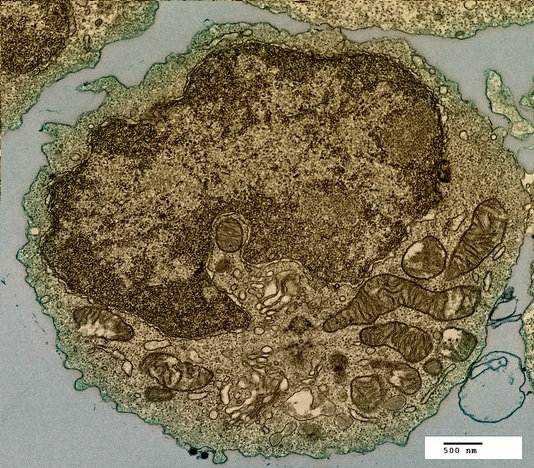
Which structure, visible in the image, could be used as evidence supporting endosymbiosis?
The mitochondria provide evidence supporting endosymbiosis because they have:
- a double membrane
- 70S ribosomes
- DNA
The image below shows two cells undergoing mitosis.
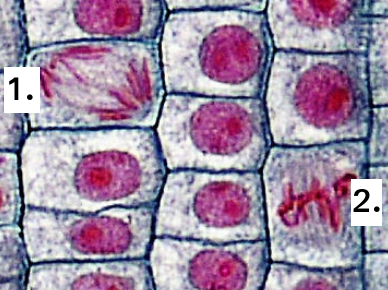
Which of the following correctly identifies the stage of mitosis for each of the cells?
Identification of the phase of mitosis is an important skill.
The position of the chromosomes gives the best clue.
In Prophase, they are spread around the cell, and double stranded.
In Metaphase, the chromosomes are lined up on the spindle equator.
In Anaphase, the chromosomes are moving to opposite poles of the cell.
In Telophase, the two groups of chromosomes are separate, sometimes with a nuclear membrane.
Which one of the statements below best describes the mitotic index?
The mitotic shows the speed of cell division, which can be used as a tool to identify cancer.
It is calculated by dividing the number of cells doing mitosis by the total number of cells.
The electron microscope image below shows three organelles found in an animal cell.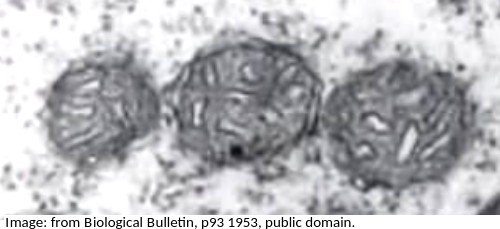
What is the name of the organelles?
Know how to idenfity the organelles in eukaryotes and draw their compartmentalised structure.
A mitochondrion (pleural = mitochondria) has an outer membrane and inner membrane folded into long thing 'flaps' called cristae.
The electron microscope image below shows an organelle found in both animal and plant cells.
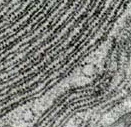
What is the name of the organelle?
Know how to idenfity the organelles in eukaryotes and draw their compartmentalised structure.
The rER has parallel membranes covered in dots, which are ribosomes, used for making proteins, for secretion from the cell.
What are the structures labelled X and Y likely to be in this electron microscope image?
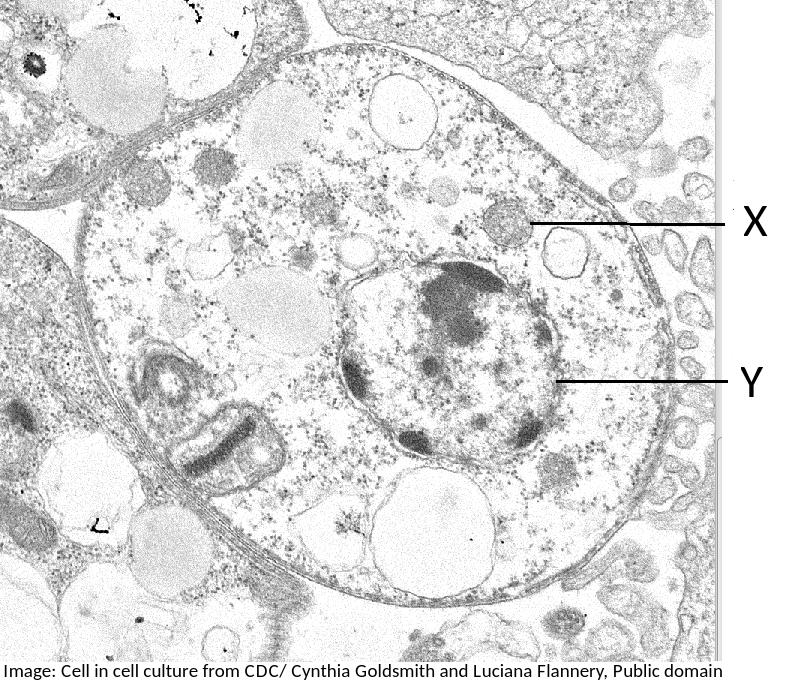
Students are expected to be able to identify organelles from microscope images of cells. The nucleus is distinctive because it is about 10µm in size, and it has black dots in it, chromatin, and sometimes one or more dark patches within the nuclear membrane. It also has a double membrane, not often easily visible.
Stargardts disease is vision loss caused by the death of both cone cells and rod cells in the part of the retina around the fovea. One potential treatment for Stargardts disease is the use of human embryonic stem cells.
What are the properties of these stem cells, which other cells don't have, that makes them so useful for this treatment?
Stem cells can divide and this help researchers to grow them in the lab.
They can differentiate along different pathways in embryonic development which makes stem cells useful for therapeutic uses (e.g. Stargart's disease) because they can be grown into many different tissues.
Explain the significance of the following terms in Biology; Metabolism, response, growth, reproduction, excretion, nutrition, homeostasis.
Remember MR H GREN. These letters represent the seven characteristics of living things.
Stargarts disease, which causes loss of cells in the retina can be treated using a special type of human cell.
Which of the following is used because it is still able to differentiate?
Stem cells can differentiate and become specialised cells.
They often take on the features of the cells around them.
Rod cells, cone cells, and erythrocytes are specialised cells and cannot differentiate.
The image below shows a eukaryotic cell.

Which structure, visible in the image, could be used as evidence supporting endosymbiosis?
The mitochondria provide evidence supporting endosymbiosis because they have:
- a double membrane
- 70S ribosomes
- DNA
Protein channels cross the membrane to allow hydrophilic substances to pass through the membrane.
What is the sequence of events that occur in a cell that is secreting a protein hormone?
1 Exocytosis
2 Vesicle formed by Golgi Body
3 Fusion of vesicle to plasma membrane
4 RER manufactures protein.
Ribosomes on the RER manufacture protein. This is packaged in vesicles by the Golgi Body and moves to the surface of the cell where the vesicle and plasma membrane fuse and exocytosis of the protein occurs.
Which is the best description of the genetic code?
The genetic code is universal (the codons code for the same amino acid in all organisms) but there are a very few exceptions, mostly in Archaea. A mutation does not alter the genetic code, it alters the base sequence of DNA.
What is the structure of the genetic material found in a mitochondrion?
Mitochondrial DNA is a single helical molecule, not associated with protein and circular in shape. The same as prokaryote nucleoid DNA.
Identify the stage of mitosis of cells 1 and 2

In cell 2, the chromatids are aligned on the equator (seen from above)- Metaphase. In cell 1, the chromatids are moving towards the poles - Anaphase.
What is the name of the process by which a white blood cell can engulf a pathogenic bacterium?
Endocytosis ("into the cell") is the process by which cells can engulf particles.
All eukaryote cells have differing combinations of the same types of organelles. How can this be explained?
Similarity in structure and function are taken as evidence of a common ancestor. All of the other statements are partially true but do not provide an explanation.
Which of the following is the best description of an organelle?
The "wrong" answers are correct statements but are distractors, not the best description.
There are twenty complete cells in this microphotograph (with complete nuclear material). Estimate the number of complete cells in prophase of mitosis.

There are 3 complete cells in prophase (chromosomes visible in a nucleus..
Refresh this page to try a new set of 20 multiple choice questions. The questions will be different next time you visit. Great revision.


 Twitter
Twitter  Facebook
Facebook  LinkedIn
LinkedIn